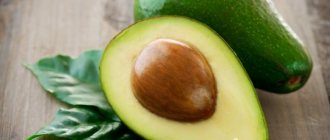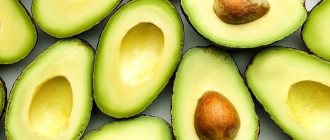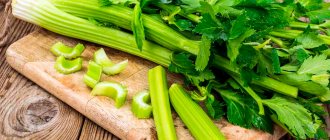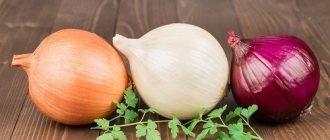Avocado is an exotic vegetable that has gained popularity among adherents of proper nutrition and lovers of haute cuisine. Combined with the unique properties and abundance of microelements, the range of fruits on store shelves is growing. In an effort to buy more exotics at a good price, you have to wonder how to store avocados at home so that they do not spoil and how to extend the shelf life of the product.
What factors affect the shelf life of avocados?
It is possible to determine how to properly store avocados by identifying the reasons that affect the freshness and storage time:
- Temperature - avocados grow in warm, exotic countries, but high temperatures are not good for storage - the higher the degrees, the more moisture the vegetable evaporates, and the more opportunities for harmful bacteria to reproduce;
- Humidity - the birthplace of the fruit is hot and dry countries (Chile, Mexico, Peru), so excess moisture instantly activates the work of bacteria that promote rotting;
- Light - reducing the amount of light for a picked vegetable helps preserve the structure of vitamins and beneficial properties;
- Air - if you cut an avocado in half, after some time the flesh will darken, oxidation will occur, like apple pulp, but it is not necessary to cut the fruit for it to begin to deteriorate from exposure to air.
The shelf life is also affected by the initial condition of the vegetable when purchased - an initially overripe fruit will not be stored for even a day, and after a couple of days it will darken inside, then outside. Before purchasing, read how to choose the right avocado for storage.
Where to store avocados at home?
Where to store avocados? Several options come to mind: refrigerator, kitchen cabinet, just leave it on the table. The storage location is determined by the level of maturity and variety of the fruit.
Before choosing a storage method, determine the level of fruit ripening:
- Press on the surface - a ripe avocado will eliminate the dent and elastically return the surface to its original shape;
- Consider the place under the stalk - the ideal color of a tasty vegetable is greenish, while white and yellow indicate an unripe fruit, and brown indicates an overripe one;
- Look at the skin - it has different shades of green, but the general rule for everyone is that it should have a uniform color, without brown spots or blotches.
Can avocados be stored in the refrigerator?
A purchased ripe fruit will delight lovers of its unusual texture for as long as the avocado is stored in the refrigerator - 3-5 days. To extend the period, first place the vegetable in a bag that does not allow the gas emitted by other vegetables and fruits to pass through.
Use refrigerated storage for mature specimens. If hard fruit is placed in cold temperatures, ripening will be slowed down or will not occur.
Can avocados be frozen for storage?
Storing in the freezer will answer the question of how to store overripe avocados at home in an apartment.
If the fruit is about to spoil or has already begun to brown inside, place it in a sub-zero temperature zone. First, wash the fruit thoroughly, remove the pit, cut it in half, remove the intact flesh from the “boat,” then cut it into pieces or mash it.
This avocado can easily be used in smoothies with celery and spinach, smoothie bowls for breakfast, or the famous snack for nachos - guacamole (add chopped ripe tomato, salt, lemon or lime juice, chili to the puree - you get a simplified Mexican snack).
It is possible to preserve the whole fruit: remove the pit, brush the surface with sour juice to prevent it from darkening, wrap it in cling film and put it in the freezer.
Storage for up to six months (ripe - 3-4 months, unripe 5-6).
Can avocados be stored in a cupboard?
Storage in a closet - suitable for “green” specimens.
How to keep avocados in the cupboard longer while achieving full ripening:
- Wash and dry the vegetable;
- Put it in a craft bag;
- If you want to achieve faster ripening, add a banana to the bag, which releases ethylene, which promotes ripening.
- If you prefer natural ripening, skip the banana idea and isolate the fruit stored in a drawer.
Do not forget to regularly check readiness, since vegetables ripen within 1-2 days, the time is determined individually and is justified by several factors.
Freezing Avocado
On a note! In order to use the fruit for more than two weeks, the freezing method is used. Unfortunately, the whole one should not be frozen, since after defrosting, the pulp turns into a mushy mass and it is almost impossible to remove the peel.
To freeze, prepare:
- peel, cut into two halves and remove the pit;
- chop the fruit with a knife or blender;
- add citrus juice (lime or lemon) to the resulting mixture;
- divide the prepared mixture into molds;
- Place the finished process in the freezer.
The method allows you to use the fruit as food for six months.
At what temperature is it best to store avocados?
- The temperature regime of the mature state is from +5 to +8 degrees.
- For ripening, you should adhere to a temperature of +18 to +24 degrees.
- The temperature in the freezer should not exceed -25 degrees.
Temperature criteria largely depend on the selected refrigerator mode and room temperature. Therefore, before starting the ripening or storage process, make sure that the parameters are correctly selected.
How to store cut avocado?
When the vegetable turns out to be large and is not useful for use, but throwing away an expensive product is wasteful, questions arise about how to store a cut avocado in the refrigerator and how to store half an avocado so that it does not darken.
The main opponent of darkening of avocado pulp is acid. Lemon or lime. It protects the surface from contact with air and oxidation. Orange juice and even vinegar are suitable for these purposes, but they change the taste of the fruit, so use lemon:
- Rinse and dry the casing thoroughly;
- Cut in half or into quarters, removing the pit;
- Gently brush the surface with lemon extract using a brush;
- Assemble parts into whole avocado;
- Wrap the vegetable in film.
Now put it in the refrigerator and store for up to two days.
Consequences of improper storage
Improper storage of avocados can lead to spoilage of the fruit. This product should be discarded immediately. Eating low-quality avocados can lead to serious poisoning. It is especially dangerous to use spoiled or very overripe pulp for baby food.
Signs of a low-quality product:
- surface too soft;
- brown spots on the skin;
- the peel is slippery to the touch;
- the fruit has an unpleasant odor.
How to store ripe avocado?
Ripe avocados can be easily stored in the refrigerator or freezer, depending on the degree of ripeness and the length of time for which the fruit needs to be stored before use:
- If you want to preserve the shape for making avocado toast or salads for the next 2-3 days, use refrigerator storage;
- If you plan to make a sauce or smoothie in the next six months, choose chopped storage in the freezer.
In the case of a refrigerator, take into account the tips with film and sour juice.
How to defrost?
To defrost the avocado, you need to transfer it to the refrigerator compartment. In this case, the temperature in the refrigerator should vary from +2 to +4°C. An alternative to this method is to leave the food at room temperature.
Do not re-freeze as oxidation occurs during defrosting.
How to store an avocado so that it ripens at home?
If you purchase an unripe fruit, another question arises: where to store the avocado so that it ripens faster?
Try one of the common storage methods:
- In a dark place in a closet;
- Wrapped in a package.
Storing avocados in foil won't be particularly effective, but if you want a ripe, soft avocado within thirty minutes, try baking it in the oven.
In all cases, careful monitoring is necessary so as not to miss the moment of the required degree of maturity.
Which fruits should you choose?
Fully ripe fruit should be purchased if you plan to consume it within the next few days. The degree of maturity is determined by the structure. When pressing on the fruit, a small dimple should remain on its surface.
- The unripe fruit has a bright green, rather hard peel. It itself is hard to the touch, and its taste is slightly reminiscent of unripe pumpkin. Peeling such an avocado and getting the pit out of it is quite difficult.
- The peel of a ripe fruit has a dark green, uniform color. With the exception of the Hass variety, which is considered the largest and turns black when fully ripe.
- The flesh of a ripe avocado has a yellow-green color and an oily texture, and the pit is easily separated from it when cut.
- The skin of a ripe fruit can be easily removed by hand, and the taste of a ripe avocado cannot be bitter.
It is best to buy fruits intended for storage when their skins are still bright green. When it is dark, the fruit should be consumed within a short time.
How to extend the shelf life of avocados?
How to preserve avocados for a long time:
- Do not choose overripe fruit that was ready for consumption yesterday; its shelf life tends to zero even in the freezer;
- Observe storage conditions that exclude contact with gases and light;
- Store the cut avocado in the refrigerator or freezer, following the conditions for processing with citric acid and cling film.
Using these tips, it’s easy to understand how to store avocados at home so that they don’t spoil, while enjoying an exotic fruit rich in vitamins all year round.
Please rate how useful this article was to you! (No ratings yet)
Yandex recommends - the best articles on the site
You may also be interested in
- How to ripen an avocado at home?
- How to choose the right ripe and tasty avocado in the store?
- How long do raw eggs last in the refrigerator and...
- How to properly store coffee beans and ground coffee at home?
- How long does frozen meat last in the freezer?…
- How to properly store greens in the refrigerator in...
- How long can boiled eggs be stored in the refrigerator and...
- How long can meat be stored in the refrigerator? Conditions and...
- How to remove yellowness from plastic at home?
- Instructions: how to properly wash horizontal...
- Step-by-step instructions: how to properly clean your apartment
- How to properly thaw frozen meat in...
Avocado selection rules
The ripeness of an avocado is determined by the color of the peel, density, stem and pit.
There are four degrees of maturity:
- pale green color – unripe state;
- darker shade - will become ripe at room temperature within 24 hours;
- dark or yellow color indicates fully ripe fruit;
- black or dark symbolizes a spoiled product.
On a note! Different varieties ripen individually; in some, the sign of ripeness is dominated by a purple hue, so it is worth carefully examining the appearance of the “alligator pear.” Be sure to avoid taking damaged or blemished fruits, as this will significantly reduce shelf life.
The density characteristic implies the following criteria:
- hard, exotic is not ripe, but at home it can become the required density in seven days;
- the finger sinks a little when pressed and returns to its original state - ripening takes 48 hours;
- a dent appears, but also returns to its original appearance - ready for use;
- soft, the skin is torn - overripe.
It is the varieties that have a dark color that are determined by their hardness.
On a note! Using the torn tail of the fruit, the ripening of the fruit is determined; if the peel underneath is brown or green, this indicates full ripeness; a dark color indicates spoilage of the fruit. If the tail is removed without effort, the avocado is ripe; the stalk is difficult to remove, which means it is not yet ripe.
The degree of ripeness is determined by the seed; if it is removed well, this indicates the readiness of the product; it sits firmly, then it needs a little support in the house.
Also read: Methods for storing chicken eggs











